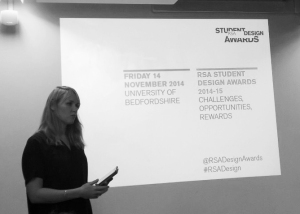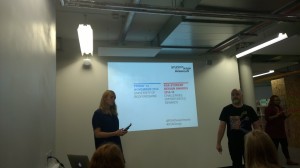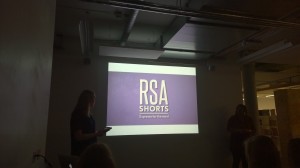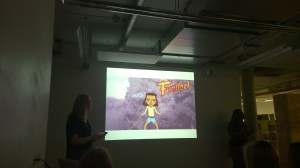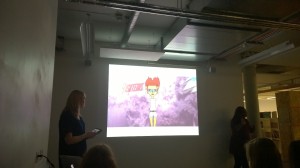REVIEW: REBECCA FORD – RSA TALK
Written by Domenika Grinkeviciute-Jotke
The RSA, in other words the Royal Society for the encouragement of Arts, Manufactures and Commerce, is an enlightenment organisation committed to finding innovative and creative practical solutions to today’s social challenges.
The talk was given by Rebecca Ford on the 14th of November.
What does RSA do? They provide an Action of Research centre – deliver the project briefs; membership organisation – sums up to 27,000 strong fellowship, inspiring people to be active in creating a better world; public talks and lectures on all raging topics or issues; RSA Animate – animations to make lectures more accessible in the contemporary society.
Eames quote that sums up the RSA: ‘’What are the boundaries of design? What are the boundaries of problems?’’.
Ford started her talk by introducing us to the Royal Society of Arts. It was founded in a coffee shop in Covent Garden in 1754 and is based in London. RSA is committed to creating enterprises to common good and their briefs that are focused on environmental and similar issues.
She continued her talk with examples of the RSA student awards, founded in 1924, the longest continuous running student design program in the world. She highlighted few artists and designers, for which, as she mentioned, RSA has helped to shape their lives in many ways. The names include Jonathan Ive, the designer of many Apple’s products, which include the well-known iPhone and iPad. J. Ive said: ”I’m glad that on such a fabulous and significant occasion, I have the opportunity to say thank you for the RSA for the enormously important role it’s played in my life”.
In the year 2000 RSA went through a big shift. The RSA Student Design Awards were founded. It is challenging emerging designers to tackle pressing social, environmental and economic issues through design thinking. But why design? Design itself has a unique ability to influence people and future of human experiences. This is why designers need to think of how to use this power in making a difference – design is more than aesthetics.
Students have been as well introduced to the recent Student Design Awards briefs: Creative Conditions; Moving Pictures; Water for All; The Daily Diet; Human by Nature; Fair Play; Mobility City; Heritage by Design.
At the end of the talk, Rebecca Ford has been highly inspiring students to participate in the RSA Student Awards competitions. She suggested, that to create an inspiring and successful design or a product students have to have a particular interest in the chosen brief, the research needs to be human based and has to tell a story of the creative process, the final product needs to look and feel well designed, important to use less text and make the product easily read for audience coming from different backgrounds and most importantly it has to be unique and surprising.
Here is the ‘Top 8 Tips for a Strong Submission’:
- User-centred research is crucial
- Capture your research effectively
- Tell a story
- Demonstrate you’ve met the judging criteria
- Create a ‘hero’ image
- Do the Gran test
- Refine + hone before you submit
- Listen to your tutors
For more information visit: http://sda.thersa.org/


